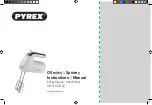
Troubleshooting — 5
Notes
Rev 3-97
* School
Cable capacitance is another issue. In general Crown recommends that you
keep maximum loop capacitance at 30 nF or less, although in most cases a loop
will operate properly at up to 40 nF. To calculate loop capacitance add up the
total loop wire length, multiply that by the capacitance per foot (or meter) rating
of the cable used, and add 60 pF per component on the loop. Restart the
calculation at the output of each Repeater in the loop. RFI is rarely a problem
with twisted pair Crown Bus cable because the Crown Bus is usually a 20 ma
current loop. Induced noise may, however, be a consideration.
PROBLEM PREVENTION (INSTALLATION TECHNIQUES)
Good installation techniques will save you a great deal of trouble after the
installation is thought to be complete. The best way to install a large IQ System
is to test the system a rack at a time, then add racks to the loop(s) one at a time.
This may seem more time consuming, but in a large system you may save hours
of work later by running a ten minute check in the equipment room.
Always use proper static handling procedures. Never pull a PIP module out or
put one into an amplifier if the amplifier is powered up. It is best to always unplug
the amplifier and wait a few seconds before taking a PIP card in or out. If you
are involved in a situation where firmware is being upgraded always ensure that
a trained technician performs the actual chip replacement.
When you setup a component one of the parameters you always have to deal
with is the component address. To save time later it is always recommended
that you mark components with their loop address and annotate system
drawings to accurately reflect those addresses.
TOOLS AVAILABLE
There are many resources available to troubleshoot an IQ System problem. The
software has a number of powerful features, the hardware also has valuable
tools built in. A good visual inspection finds many problems before you have
to use any equipment or software. Basic test equipment such a voltage meter
can tell you a great deal, and if all else fails you can always resort to checking
documentation.
Roll Call
Roll Call is the first and most important tool you have in the software. When you
run a Roll Call the software establishes communication, first with the interface,
then each component on each loop of the interface. The Roll Call reports status
step by step. It gives you status of communication with the interface, running
status of components it finds, and inventory totals. Note that all the inventory
information in the world is of little value unless you know what you are supposed
to find. It is critical that you know what the inventory should be. You should be
able to run a Roll Call and find all the components that are connected into the
system, and you should be able to get that inventory consistantly.
When you perform a Roll Call the software establishes RS232 communication
with the interface first. The interface is interrogated and must report its identity
as a component type. This process must be completed before any further steps
may be taken. Even if the software you are using does not support the
component serving as system interface, the software should recognize that an
unidentified component is the interface.




































